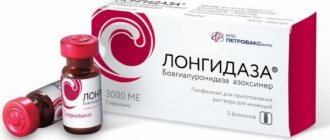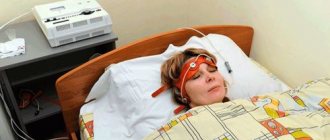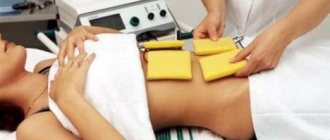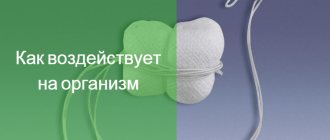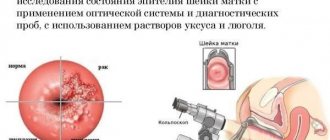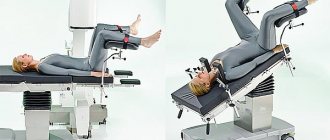Concept and relevance of the method
The essence of the method is to move small particles of the drug through the skin or mucous membranes into the patient's body. This movement is carried out under the influence of an electric field.
In domestic medicine, devices that are more than 50 years old are used. One of them is “PoTok”. However, there are also modern modifications of this device. Now “PoTok” is a modified device of a new line that meets all standards and has been produced since 2003.
The electrophoresis technique is used not only in medicine. The chemical industry is an area where the action of an electric field is used to separate and synthesize elements in molecular biology and chemistry. In addition, electrophoresis is practiced in aesthetic medicine.
What women say
Almost every review has a positive connotation. Many women noted good health after a course of electrophoresis treatment. And the use of lidase during pregnancy is a separate issue. According to reviews from former patients, it was this procedure that helped them conceive the long-awaited baby.
Some pregnant women took the course during the period of toxicosis and in this way improved their well-being, thanks to the effect on the vomiting centers of the brain.
Whatever it may be, electrophoresis is a medical procedure and should be taken seriously. Only a highly qualified specialist can prescribe it; he also takes into account the woman’s condition, contraindications, individual characteristics and possible reactions.
Electrophoresis with copper and zinc
Physiotherapy with these chemical elements is most often used in the treatment of gynecological diseases. Electrophoresis with copper on the lower abdomen is recommended for diseases accompanied by inflammation.
Therapeutic electrophoresis with copper has its advantages:
- Effective doses of drugs that have low concentrations.
- A “depot” of elements introduced using electric current is created in the body. Over time, they accumulate and have a long-term effect.
- Ions are the chemical form of the product that is considered the most active.
- Possibility of exclusively local effects on tissues, without spreading the substance through the blood and lymph flow.
- Electrophoresis with zinc and copper can be administered to places where local blood circulation is impaired.
- During electrophoresis, the drug is not destroyed, as when administered orally.
- The weak influence of electric current stimulates the reactive forces of the body.
The benefits of electrophoresis in the treatment of gynecological diseases
Treatment of female diseases is determined not only by a course of medication and vaginal suppositories. Many diseases develop due to anatomical disorders.
It is for this reason that a whole range of techniques is used. Electrophoresis in gynecology is used as often as treatment with mud.
But their meaning is similar: medicinal drugs enter the body through the skin.
Treatment of gynecological diseases with electrophoresis - an effective method
The advantage of such techniques is the preservation of the functionality of the gastrointestinal tract.
Electrophoresis is used with many drugs: magnesium, zinc, potassium, etc., but the basic principle of operation is based on the supply of direct current at a certain frequency.
Due to this effect, the patient can only undergo therapeutic procedures, without surgical intervention.
What effect does
Zinc electrophoresis has been used in gynecology for a long time, and the method itself eliminated the remains of medications in the blood of the expectant mother, thereby preventing consequences during and after pregnancy. Sometimes this procedure is much more effective than drug courses, and sometimes much safer.
Modern medicine is increasingly focusing on diseases of the female organs. There are more and more registered cases of diseases that provoke weakening of blood flow in the female genital area.
Based on research, scientists have found that the disease progresses due to a lack of drug treatment, since the active substances simply did not reach the pelvic organs, settling in healthy areas of the body.
Through research, medicine has identified several new diseases caused by excess drugs in healthy organs.
Electrophoresis will help relieve swelling
Electrophoresis with copper or another drug (depending on the doctor’s prescription) effectively combats pathologies:
- eliminates swelling;
- reduces pain;
- regenerates the skin.
Due to ion injection, there are fewer and fewer reported cases of allergies to medications, and the advantage of the method is painless injection into the right place.
An important advantage of electrophoresis with potassium iodide or copper in gynecology is the bypass of the circulatory system and the gastrointestinal tract. Due to this, the work of no organ is disrupted.
When are the procedures performed?
Indications for electrophoresis with zinc, copper, potassium, demexide are based on recent studies that have identified new diseases, and the list of diseases and therapies has increased significantly:
- chronic pathologies of the pelvic organs;
- inflammatory processes in the appendages;
- infertility;
Often performed in preparation for IVF
- postoperative rehabilitation therapy;
- regeneration of fallopian tube tissue;
- increasing the sensitivity of cells to gynecological drug courses;
- reproduction of mucous membranes;
- rehabilitation after the process of termination of pregnancy;
- relieving swelling and inflammation;
- chronic inflammatory processes;
- therapy that improves cell nutrition;
- preparatory stage of female organs for IVF.
Electrophoresis with potassium iodine in gynecology is used as a painless introduction of drugs into the vagina, creating the effect of a cup with medicine. By undergoing several courses of electrophoresis, medications are absorbed into the vagina in several doses. It is worth noting that the course must be completed in full for effective treatment.
What drugs are used
Since the therapy is based on passing current through the body's tissues, only conductive drugs are used. Their choice is based on the following parameters:
Dimexide is often used for the procedure
The most common in gynecology are:
- zinc;
- potassium iodide;
- copper;
- dimexide.
Zinc solution is widely used for therapeutic procedures for erosion and poor functionality of the corpus luteum. Zinc-based electropheresis involves the use of a solution of 0.25 or 0.5%. The treatment course reaches 30 days, and visits to the treatment room up to 15 times. The break between treatment is 60 days.
In the postoperative period, a technique with potassium iodide is usually used, since it affects pain receptors and reduces pain syndrome during adhesions.
The use of the drug is prohibited during disturbances in the functionality of the ovaries.
Typically, potassium iodine is replaced with:
Possible use of Novocaine
A complex of zinc and lidase is used in case of scarring and adhesions in the oviducts after operations. Quite rarely used due to a whole list of contraindications.
It is worth noting that 10% of women experience pain during the menstrual cycle. Sometimes the reaction to sudden painful periods is loss of consciousness. In this case, experts recommend using a 7-day treatment course using novocaine.
Does the procedure have contraindications?
Contraindications are divided into: complete, limited and general. Restrictions on procedures are introduced during pregnancy, endocrine diseases, chronic kidney damage and lung diseases.
Complete contraindications:
- cysts;
- rehabilitation period after surgery;
- bleeding;
- polyps;
- papilloma and condyloma lesions;
- any type of genital cancer;
- genetic predisposition affecting changes in the monthly cycle;
- purulent lesions.
From this video you will find out. How does electrophoresis work?
General group:
- shock intolerance;
- colds;
- temperature;
- HIV infections;
- any type of hepatitis and tuberculosis;
- wounds or cuts in the area of conduction;
- acute form of renal or liver failure;
- diseases of the circulatory system;
- alcoholism;
- drug addiction;
- psychical deviations.
Experts recommend performing electrophoresis in a stationary mode.
Source: https://mesyachnie.com/zachatie/jelektroforez-v-ginekologii.html
Pharmacology
Medicines are introduced into the body through anatomical structures that are located on the skin - through the sweat and sebaceous glands. They come in the form of negatively or positively charged ions. In this case, the percentage of the drug does not exceed 10% of the entire dose that is administered.
The medication does not immediately enter the local bloodstream, but only at least 24 hours after the procedure. The bulk of the medicine is first retained in the body’s natural filters – the skin and subcutaneous fat layer.
This is the basis for the long-term effect of the method: activation of metabolism and elimination of inflammation continues after electrophoresis.
PHYSIOTHERAPY TREATMENT
SANATORIUMS WITH TREATMENT | PHYSIOTHERAPY
Electrophoresis is a physiotherapeutic preventive and therapeutic method of influencing the body, as a result of which the active ions of the medicinal substance (solution) penetrate deep into the tissues, providing a therapeutic effect.
Thus, electrophoresis is prescribed for various diseases, mainly of an inflammatory nature, and in various fields of medicine. The attending physician determines which drug electrophoresis is used for a particular disease, and the doctor will also indicate whether it is necessary to alternate electrophoresis with another drug, what the dosage should be, the duration of the procedure and the course of treatment. Buying medicinal substances for electrophoresis is not difficult. During electrophoresis, various medications are used for different indications, for example, lidase, papaverine, aminophylline, potassium iodide, zinc, copper, various groups of antibiotics, etc. For example, in gynecology, the choice of drug for electrophoresis is determined by hormonal levels,
the activity and functionality of hormone-dependent and genital organs, in particular the ovaries, during certain inflammatory processes, for example, an adhesive process. If the ovaries function normally, without complications during the acute phase of adhesive disease, electrophoresis with the administration of iodine should be prescribed. If there is hypofunction of the ovaries of the female reproductive system when adhesive disease is activated, electrophoresis with copper and zinc is prescribed. But in this case, it is important to make sure that the body is in a state of estrogen saturation, and in the case of non-functional corpus luteum of the ovaries, only electrophoresis with zinc should be used.
The zinc solution is administered using electrophoresis, following the cutaneous-vaginal method. Electrophoresis procedures with zinc are prescribed every day or every other day, the duration of the treatment course is usually 25-30 procedures. Between courses of electrophoresis it is necessary to take breaks, which can be no more than two months. In addition to the adhesive process, in gynecology, electrophoresis is prescribed for endometriosis, fibroids, fibroids, diffuse mastopathy, etc.
The inflammatory process in a woman’s genital organs can be combined with another non-inflammatory disease, for example, fibroids; the electrophoresis solution contains zinc and iodine ions. Thus, iodine inhibits the secretion and release of follicle-stimulating hormone, and zinc stimulates the secretion and release of luteinizing hormone from the main gland of the body - the pituitary gland.
With fibroids, the zinc content in a woman’s body decreases, and the amount of copper ions increases, and in a state of complete health, these data are completely opposite. To treat this imbalance, electrophoresis is performed using a zinc solution on the lower abdomen, this inhibits the growth of fibroids and reduces hyperestrogenemia.
In adolescence, the development of female genital organs may not correspond to age-related indicators due to various reasons, mainly hormonal dysfunction; for this purpose, copper is administered by electrophoresis.
ovarian hypoplasia, etc. Electrophoresis in gynecology is contraindicated in the case of genital tuberculosis, sexually transmitted diseases, chronic inflammatory processes, etc.
In addition to gynecological applications, zinc solution is used in the field of rheumatology, for example, for the treatment of arthrosis, spondylosis, etc. A microelement such as zinc is necessary for adequate life and function of connective tissue, tendons, muscles, ligaments, joint capsule and capsule.
Mechanism of action
Electric current and electromagnetic field cause the ions to move. The current acts on the tissue continuously, and pulsed flows move particles along the lines of force. The method uses negative and positive electrodes. In this case, negatively charged ions are repelled from the same electrode, the same applies to positive ions.
Antiseptic effect on tissue is the main function of copper and zinc salts. At small doses, these elements simply prevent bacteria from growing, and at large doses, the bacteria are destroyed. This mechanism of action is due to the characteristics of salts: their organic compounds block the life processes of bacteria, inhibit their reproduction and cause death.
In addition to their bactericidal properties, copper and zinc, when applied topically, contribute to skin irritation. The result is increased blood flow, greater supply of nutrients and increased tissue regeneration.
Electrophoresis in gynecology
Advisory services
| Consultation with a gynecologist-endocrinologist (30 min) | 1800 rub. |
Physiotherapy has long earned the right to be called one of the most effective and gentle methods of treating various diseases.
Electrophoresis in gynecology is used as the most optimal painless means of administering medications with the aim of depositing them directly in diseased tissues and organs.
What is the procedure
The essence of the method is the use of weak electrical discharges, thanks to which active medicinal substances enter the body through the skin.
Positively and negatively charged electrodes are attached to the patient’s body in the projection of the unhealthy organ, delivering a weak current. Under its influence, the elements of the drugs disintegrate into tiny particles - ions and penetrate into the sebaceous and sweat ducts of the skin.
Opposite charges on both sides of the body create an electromagnetic field, which ensures the movement of the medicine to the sore spots.
Electrophoresis is characterized by:
- accuracy of impact - drugs enter directly into the diseased organ, without loading the entire body;
- minimum required medications - ions are highly active, and a small amount of drugs is sufficient for their formation;
- quick results - the therapeutic effect is achieved after 1-2 procedures;
- painless, well tolerated - there is no need for punctures, tissue trauma, extreme temperature conditions, patients feel only a barely perceptible tingling or warmth;
- a narrow range of contraindications - subject to certain restrictions, use during pregnancy is possible.
Indications and contraindications
Diseases for which electrophoresis is indicated:
- ENT organs: sinusitis, otitis, frontal sinusitis and rhinitis.
- Respiratory system: pneumonia, pleurisy, chronic and acute bronchitis.
- Digestive system: ulcers, gastritis, inflammation of the pancreas, cholecystitis.
- Cardiovascular system: atherosclerosis, endarteritis, varicose veins.
- Genitourinary system: urethritis, prostatitis, endometriosis, cystitis.
- Skin: burns, ulcers, dermatitis, scabies, carbuncles and boils.
- Diseases of the eyes, peripheral nervous system.
- Infertility in women.
In exceptional situations, electrophoresis is indicated for infants in the following conditions:
- Burns.
- Diseases of the ear, nose and throat.
- Diseases of the musculoskeletal system.
There are absolute and relative contraindications to the procedure. Absolute (meaning electrophoresis cannot be done at all) include:
- individual intolerance to current;
- high body temperature;
- blood clotting disorder;
- menses;
- decompensated cardiovascular failure;
- installed pacemaker;
- mental disorders: schizophrenia and bipolar affective disorder, psychotic conditions.
Relative:
- pregnancy;
- hypertonic disease.
Contraindications to the procedure
Although electrophoresis is one of the most widely used medical procedures, it also has contraindications:
- Tumors of varying degrees;
- Pathologies of blood vessels and heart. But not all, some types of this type of disease require additional consultation with a specialist;
- Increased body temperature;
- Inflammatory process in the body;
- Skin problems such as eczema, dermatitis;
- Individual intolerance to a medicinal substance or electric current;
- Mechanical damage to the skin at the sites where the electrodes are applied;
- Presence of an artificial pacemaker (pacemaker);
- A disorder associated with blood clotting;
- Severe form of bronchial asthma.
Menstruation is not an absolute contraindication to the electric current treatment procedure. Menstrual bleeding is a natural process that was not created “specifically” by an external or internal factor (inflammation or infection). Electrophoresis is not advisable during the period of bleeding, if the place where the electrodes are applied is the area of the uterus or ovaries.
Methodology
The drug is applied perpendicular to the electric current: between the applied electrode and the skin. The further method of drug administration depends on the type of zinc and copper electrophoresis:
- Galvanic. A gauze bandage is soaked with medication and applied to the area of the body on the opposite side of the inflammation. This is necessary to create an electric field. Electrodes are placed in gauze and covered with film on top. For example, electrophoresis with zinc on the lower abdomen. For a better effect, you can additionally apply an ointment or cream containing copper and zinc.
- Vannochkovy. A solution containing zinc and copper is poured into a container with built-in electrodes. The patient’s task is to immerse the affected part of the body in this bath.
- Cavity. One electrode and zinc sulfate for electrophoresis are introduced into the organ cavity. The second electrode is located on the surface of the skin, forming a field in which zinc or copper ions move.
- Interstitial. The patient drinks the medicine or it is administered by injection, after which cathodes and anodes are placed on the affected area.
At home
The procedure can be performed at home. First you need to buy a physiotherapy device, a zinc solution for electrophoresis and consult with your doctor. In some cases, you can hire a nurse for the first time to show you how to use the device correctly.
Physiosphere - Electrophoresis - a method of administering medicinal substances
Electrophoresis is the therapeutic effect of direct electric current with the use of medications to achieve a rapid therapeutic effect.
The medicine is applied to reusable electrodes with conductive fabric. The possibility of introducing a substance into the body by electrophoresis is determined by the degree of electrolytic dissociation of the substance.
Electrophoresis is possible: caripain, fermenkol, calcium, potassium, magnesium, novocaine, analgin, etc.
Indications
- spondylosis with moderate pain syndrome;
- arthrosis in the stage of moderate exacerbation.
Mode of application
The procedure is similar to galvanization. Novocaine has an analgesic and anesthetic effect on problem areas of the body. The amount of the drug, as well as the size of the electrodes, depends on the severity of joint damage.
Peculiarities
The anode (positive electrode) should be placed in the area of maximum pain. A medicated 3-4-layer gauze or filter paper moistened with a 0.5% novocaine solution (2-10 ml) should be applied to the body. For the ankle – 2-4 ml, for the hip joint – 8-10 ml.
Duration of treatment
The procedure lasts 15-30 minutes, daily, for 10-20 days, depending on the dynamics of pain syndromes.
Electrophoresis of analgin, sodium salicylate, baralgin
The drugs have not only anti-inflammatory, but also a pronounced analgesic effect.
Method of application and features
Analgin moistened in an ampoule solution (50%) (ratio 1/10, quantity – 2-15 ml) is placed between the electrode (–) and the problem area. A medicinal pad with a 0.5% solution of novocaine hydrochloride (2-10 ml) is placed under the electrode (+)
Treatment duration is from 15 to 30 minutes every day, from 10 to 20 sessions.
Purpose of application:
Preservation of the structure and integrity of articular cartilage
Lithium or zinc electrophoresis
These microelements are needed for the normal functioning of ligaments, tendons, joint capsules and capsules, and connective tissue.
Features of the method
A napkin moistened with a 2% zinc sulfate solution or a 3-5% lithium chloride solution is placed between the anode electrode and the patient’s body. The amount of liquid is 2-5 ml.
Iodine electrophoresis
The procedure has a good absorption effect due to the microelement used (iodine).
Nicotinic acid electrophoresis
The main effect of the microelement is a pronounced vasodilator effect.
Duration of treatment
Daily sessions for 15-30 minutes for 10-20 days.
Electrophoresis of aloe (mud squeezes)
The components of therapeutic mud and aloe improve tissue nutrition, have a resorption and trophic effect, and anesthetize the affected tissue areas.
Treatment method
Under the anode and cathode, pads moistened with a medicinal solution (diluted ¼) with water or a squeeze of medicinal mud are placed. The amount of liquid is 5-15 ml.
The duration of the procedure is 15-30 minutes, treatment is carried out daily for 10-20 days.
Electrophoresis of therapeutic mud
The medicinal components that make up the mud masses are biopolarly mobile in the electric field, so electrophoresis is carried out from both electrodes.
Electric mud therapy is used in the following cases:
- progressive course of spondylosis and arthrosis (not during the period of exacerbation);
- pain;
- fibrous and articular changes;
- increase in joint size;
- bone tissue dystrophy;
- circulatory disorders.
Methodology
Mud cakes 1.5-2 cm thick wrapped in a 3-4 layer gauze bandage are placed under the cathode (+) and anode (-), the temperature of the mass should not exceed 40-42 degrees Celsius.
Duration of treatment: 15-30 minutes, at least 10-20 daily procedures are required.
Bischofite electrophoresis
The natural mineral bischofite contains a complex of minerals with a high content of K+, Cl-, HCO 3-, HSO 4-, Ca 2+, Mg 2+.
Application
- treatment using application method;
- compresses;
- is entered from both poles (+, –).
Operating principle
- trophic resorption effect;
- improving nutrition and blood circulation of tissues;
- anesthesia.
